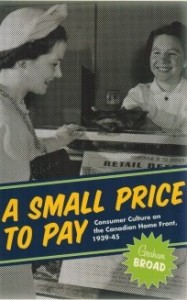It’s the fact that never fails to provoke nostalgia, anger or simple disbelief. For one magic generation from about 1952 to 1972, Canadians lived in a workers’ paradise. A single wage earner made enough to support a whole family. Most everyone could buy a home even if it was only 1100 square feet, and a typical Canadian had steady work with one, maybe two employers on the promise of a gold watch and pension.
Historian Graham Broad of Western University argues we have this all wrong: the golden years actually started a decade earlier. If the 1940s are cast as a gaunt era of wartime sacrifice, Broad notes that for the 99 percent of Canadians who were not in combat those years were frankly wonderful. “It’s a terrible thing to say, but I hope the war goes on for a long time,” as one Depression survivor told a newspaperman.
If the government rationed coffee in 1942, the quota was a none-too-dire 12 cups a week, and even that was lifted by 1944. If cabinet slapped a 25 percent luxury tax on jewelry, retailers reported it had no apparent impact on sales. Butter was rationed but only to stop hoarding. Wartime farm production actually doubled nationwide. If 1944 was the year Canadians fought their way up the boot of Italy, it was the same year Maclean’s reported that “night life in Montréal is booming like Big Ben on Armistice Day.”
Broad writes, “Canada’s declaration of war in September 1939 touched off the biggest proportional consumer spending boom in the country’s history.” In two years unemployment fell by three-quarters and per capita retail sales jumped 20 percent.
A Small Price To Pay is wry, ironic and wonderfully researched. It is also a dramatic resetting of the record. Far from the media depiction of 1940s Canada as a bleak and downcast place, Broad makes a persuasive case that most people never had it so good.
As France fell and Britain was blitzed, Canadians could still buy automobiles, lipstick and ice skates. Broad recalls when the Pacific war ended rubber imports, “Housewives complained to the Women’s Regional Advisory Committees about children’s skirts and pants that fell down, drawstrings being no substitute for the elastic waistbands!”
Where austerity was undeniable, the impact was not too devastating. Production of fridges and electric toasters was virtually eliminated by 1942, but only 20 percent of farmers had electricity anyhow. Gasoline was rationed in 1942 but drivers were still entitled to 5,000 miles worth of fuel a year, and one immediate impact was a 26 percent reduction in traffic deaths as highway speed limits were lowered to 40 mph.
“The Second World War was, in many respects, a period of progress in the development of the modern consumer economy, rather than the time of consumer deprivation that it is usually made out to be,” Broad explains. “Most histories of the home front, when they have addressed consumption at all, have placed an inordinate emphasis on rationing, shortages and propaganda urging consumer restraint. Although these were undeniably important aspects of home front life, there were few shortages until late 1941, rationing did not begin until 1942…and in the first two years, calls for increased consumer spending were far more common than calls for restraint.”
For young Canadians and even for those who lived it, the war years are immortalized as a black-and-white period of communal misery and sacrifice. A Small Price To Pay reruns the memory reel in brilliant colour punctuated with an astonishing fact. In no year of the war did Canada spend more on the military than it did on shopping.
By Holly Doan
A Small Price To Pay: Consumer Culture on the Canadian Home Front 1939-1945, by Graham Broad; UBC Press; 288 pages; ISBN 9780-7748-23647; $32.95






